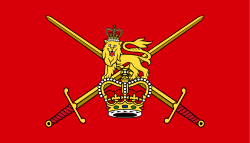History
The formation of the Corps of Army Music was triggered by a defence review known as Options for Change in 1991 and followed a 1993 announcement by the Chief of the General Staff that the number of regular army bands was to be reduced from 69 to 30. The period saw the number of personnel fall from 2,000 to 1,100, with Lieutenant Colonel Roger Tomlinson of the Royal Military School of Music describing it as "a gloomy time for those of us in the military music business". [1] The Queen signed a warrant on 13 August 1994 to allow the formation of the Corps of Army Music. All regular army officers who were Directors of Music in the various corps and regiments and all regular army musicians would transfer to the Corps of Army Music - now the newest and most junior corps in the army - on 1 September 1994. [2]
The home of the corps was established at Kneller Hall in Twickenham, a site that already encompassed the Royal Military School of Music. The school was founded by the Duke of Cambridge, soon after his appointment as Commander in Chief in 1857, when the first class of military musicians was formed, a 'Class of Music'. The establishment was retitled as The Royal Military School of Music by Queen Victoria in 1887. [2]
The Future Army Structure review of 2004 saw the bands of the Regular Army reduced from 30 to 23. [3] In 2019 the number of Regular Army bands was further reduced to 14. [4]
2019 restructuring
In 2019, the Corps of Army Music was restructured with a number of bands being co-located and re-named. [5] In a process of 'Military Music Optimization', the regular Army band laydown was adjusted to enable several smaller bands to train and perform as larger bands for more significant Army events: 'Co-locating 11 of the smaller bands in three major garrisons and Sandhurst has increased the flexibility of CAMUS to perform at a huge breadth of events without compromising any of the traditional bands that have been performing for many years'. [6]
Renaming and move
During a visit to Kneller Hall in December 2020, the Earl and Countess of Wessex announced the Corps of Army Music would be renamed the Royal Corps of Army Music from January 2021. [7] This change was formally marked with a new title presentation in January 2021 with the Countess in attendance. [8]
In September 2021, the Corps Headquarters moved to Gibraltar Barracks in Minley, whilst the Royal Military School of Music moved to HMS Nelson alongside the Royal Marines School of Music. [9]
This page is based on this
Wikipedia article Text is available under the
CC BY-SA 4.0 license; additional terms may apply.
Images, videos and audio are available under their respective licenses.

